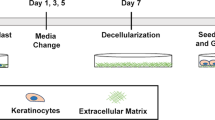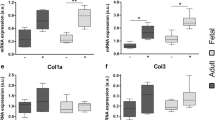Abstract
Neonatal human dermal fibroblasts cultured in vitro synthesize an organized and physically substantial three-dimensional extracellular matrix, without the addition of exogenous matrix components or synthetic scaffolds. De novo matrix synthesis proceeds in an orderly manner over a 21-d culture period and beyond. Analysis of the fibroblast phenotype, i.e., matrix synthesis by the fibroblasts, suggests that both serum and serum-free conditions are conducive to the production of a human tissue-engineered “dermal equivalent”. We report that given the appropriate permissive environment, the fibroblasts establish and grow a tissue in vitro, which bears striking biochemical and physical resemblance to normal human dermis.








Similar content being viewed by others
References
Auger F. A.; Pouliot R.; Tremblay N.; Guignard R.; Noel P.; Juhasz J.; Germain L.; Goulet F. Multistep production of bioengineered skin substitutes: sequential modulation of culture conditions. In Vitro Cell. Dev. Biol.-Animal 36: 96–103; 2000 doi:10.1290/1071-2690(2000)036<0096:MPOBSS>2.0.CO;2.
Babu M.; Diegelmann R.; Oliver N. Fibronectin is overproduced by keloid fibroblasts during abnormal wound healing. Mol. Cell. Biol. 9: 1642–1650; 1989.
Bailey A. J.; Sims T. J.; Le Lous M.; Bazin S. Collagen polymorphism in experimental granulation tissue. Biochem. Biophys. Res. Commun. 66: 1160–1165; 1975 doi:10.1016/0006-291X(75)90480-5.
Bell E.; Ehrlich H. P.; Buttle D. J.; Nakatsuji T. Living tissue formed in vitro and accepted as skin-equivalent tissue of full thickness. Science 211: 1052–1054; 1981 doi:10.1126/science.7008197.
Black A. F.; Bouez C.; Perrier E.; Schlotmann K.; Chapuis F.; Damour O. Optimization and characterization of an engineered human skin equivalent. Tissue Eng. 11: 723–733; 2005 doi:10.1089/ten.2005.11.723.
Boyce S. T.; Christianson D. J.; Hansbrough J. F. Structure of a collagen-GAG dermal skin substitute optimized for cultured human epidermal keratinocytes. J. Biomed. Mater. Research 22: 939–957; 1988 doi:10.1002/jbm.820221008.
Bradford Rockwell W.; Cohen K.; Ehrlich P. H. Keloids and hypertrophic scars: a comprehensive review. Plast. Reconstr. Surg. 84: 827–837; 1998.
Calabro A.; Benavides M.; Tammi M.; Hascall V. C.; Midura R. J. Microanalysis of enzyme digests of hyaluronan and chondroitin/dermatan sulfate by fluorophore assisted carbohydrate electrophoresis (FACE). Glycobiology 10: 273–281; 2000a doi:10.1093/glycob/10.3.273.
Calabro A.; Hascall V. C.; Midura R. J. Adaptation of FACE methodology for microanalysis of total hyaluronan in chondroitin sulfate composition from cartilage. Glycobiology 10: 283–293; 2000b doi:10.1093/glycob/10.3.283.
Chen W. Y. J.; Abatangelo G. Functions of hyaluronan in wound repair. Wound Rep. Reg. 7: 79–89; 1999 doi:10.1046/j.1524-475X.1999.00079.x.
Colwell A. S.; Longaker M. T.; Lorenz H. P. Mammalian fetal organ regeneration. Adv. Biochem. Eng. Biotechnol. 93: 83–100; 2005.
Contard P.; Jacobs L.; Perslish J. S.; Fleischmajer R. Collagen fibrillogenesis in a three-dimensional fibroblast culture system. Cell Tissue Res. 273: 571–575; 1993 doi:10.1007/BF00333710.
Danielson K. G.; Baribault H.; Holmes D. F.; Graham H.; Kadler K. E. Targeted disruption of decorin leads to abnormal collagen fibril morphology and skin fragility. J. Cell Biol. 136: 729–743; 1997 doi:10.1083/jcb.136.3.729.
David-Raoudi M.; Tranchepain F.; Deschrevel B.; Vincent J. C.; Bogdanowicz P.; Boumediene K.; Pujol Differential effects of hyaluronan and its fragments on fibroblasts: Relation to wound healing. Wound Repair Regen. 16: 274–287; 2008.
Falanga V. et al. Rapid healing of venous ulcers and lack of clinical rejection with an allogeneic cultured human skin equivalent. Arch. Dermatol. 134: 293–300; 1998 doi:10.1001/archderm.134.3.293.
Fleischmajer R.; Perslish J. S.; Burgeson R. E.; Shaikh-Bahai F.; Timpl R. Type I and type III collagen interactions during fibrillogenesis. Ann. N. Y. Acad. Sci. 580: 161–175; 1990 doi:10.1111/j.1749-6632.1990.tb17927.x.
Fosang A. J.; Hey N. J.; Carney S. L.; Hardingham T. E. An ELISA plate-based assay for hyaluronan using biotinylated proteoglycan G1 domain. Matrix 10: 306–313; 1990.
Germain L.; Auger F. A.; Grandbois E.; Guignard R.; Giasson M.; Boisjoly H.; Guerin S. L. Reconstructed human cornea produced in vitro by tissue engineering. Pathobiology 67: 140–147; 1999 doi:10.1159/000028064.
Gallo R. L.; Bernfield M. Proteoglycans in Wound Repair. In: ClarkR.A.F. (ed) The molecular and cellular biology of wound repair. Plenum Press, NY, pp 475–492; 1996.
Hakkinen L.; Hildebrand H. C.; Berndt A.; Kosmehl H.; Larjava H. Immunolocalization of tenascin-c, α9 integrin subunit and αVβ6 integrin during wound healing in human oral mucosa. J. Histochem. Cytochem. 48: 985–998; 2000.
Hantash B. M.; Zhao L.; Knowles J. A. Adult and fetal wound healing. Front. Biosci. 13: 51–61; 2008 doi:10.2741/2559.
Hata R.; Senoo H. L-ascorbic acid 2-phosphate stimulates collagen accumulation, cell proliferation, and formation of a three-dimensional tissuelike substance by skin fibroblasts. J. Cell. Physiol. 138: 8–16; 1989 doi:10.1002/jcp.1041380103.
Ishikawa O.; Kondo A.; Okada K.; Miyachi Y.; Furumura M. Morphological and biochemical analyses on fibroblasts and self-produced collagens in a novel three-dimensional culture. Br. J. Dermatol. 136: 6–11; 1997 doi:10.1111/j.1365-2133.1997.tb08738.x.
Laemmli U. K. Cleavage of structural proteins during the assembly of the head of bacteriophage T4. Nature 227: 680–685; 1970 doi:10.1038/227680a0.
Levenberg S.; Langer R. Advances in tissue engineering. Curr. Top. Dev. Biol. 61: 113–134; 2004 doi:10.1016/S0070-2153(04)61005-2.
L’Heureux N.; Paquet S.; Labbe R.; Germain L.; Auger F. A completely biological tissue-engineered human blood vessel. FASEB J. 12: 47–56; 1998.
Mackie E. J.; Tucker R. P. The tenascin-c knockout revisited. J. Cell Sci. 112: 3847–3853; 1999.
Mast B. A.; Diegelmann R. F.; Krummel T. M.; Cohen I. K. Scarless wound healing in the mammalian fetus. Surgery 174: 441–451; 1992.
Michel M.; L’Heureux N.; Pouliot R.; Xu W.; Auger F. A.; Germain L. Characterization of a new tissue-engineered human skin equivalent with hair. In Vitro Cell. Dev. Biol.-Animal 35: 318–326; 1999 doi:10.1007/s11626-999-0081-x.
Mooney D. J.; Mikos A. G. Growing new organs. Sci. Am. 113: 60–65; 1999.
Parenteau N. Skin: the first tissue engineered products. Sci. Am. 280: 83–84; 1999.
Parenteau N. L.; Hardin-Young J.; Ross R. N. Skin SubstitutesPrinciples of Tissue Engineering. Elsevier, San Diego, CA, pp 879–889; 2000.
Pittenger M. F. et al. Multilineage potential of human mesenchymal stem cells. Science 284: 143–147; 1999 doi:10.1126/science.284.5411.143.
Ragan P. M. et al. Down-regulation of chondrocyte agreccan and type II collagen gene expression correlates with increases in static compression magnitude and duration. J. Orthop. Res. 6: 836–842; 1999 doi:10.1002/jor.1100170608.
Sakai L. Y.; Keene D. R.; Engvall E. Fibrillin, a new 350-kD glycoprotein is a component of extracellular microfibrils. J. Cell. Biol. 103: 2499–2509; 1986 doi:10.1083/jcb.103.6.2499.
Scott P. G.; Dodd C. M.; Ghahary A.; Shen Y. J.; Tredget E. E. Fibroblasts from post burn hypertrophic scar tissue synthesize less decorin than normal dermal fibroblasts. Clin. Sci. 94: 541–547; 1998.
Scott P. G.; Dodd C. M.; Tredget E. E.; Ghahary A.; Rahemtulla F. Chemical characterization and quantification of proteoglycans in human post-burn hypertrophic and mature scars. Clin. Sci. 90: 417–425; 1996.
Siebert J. W.; Andrew B. R.; McCarthy J. G.; Weinzweig J.; Ehrlich H. P. Fetal wound healing: a biochemical study of scarless healing. Plast. Reconstr. Surg. 85: 495–504; 1990.
Smith L. T.; Holbrook K. A.; Madri J. A. Collagen types I, III, and V in human embryonic and fetal skin. Am. J. Anat. 175: 507–521; 1986 doi:10.1002/aja.1001750409.
Taylor K. R.; Gallo R. L. Glycosaminoglycans and their proteoglycans: host associated molecular patterns for initiation and modulation of inflammation. 20: 9–22; 2006.
West D. C.; Hampson I. N.; Arnold F.; Kumar S. Angiogenesis induced by degradation products of hyaluronic acid. Science 228: 1324–1326; 1985 doi:10.1126/science.2408340.
Wilkins L. M.; Watson S. R.; Prosky S. J.; Meunier S. F.; Parenteau N. L. Development of a bilayered living skin construct for clinical applications. Biotechnol. Bioeng. 43: 747–756; 1994 doi:10.1002/bit.260430809.
Woessner J. F. The determination of hydroxyproline in tissue and protein samples containing small proportions of this imino acid. Arch. Biochem. Biophys. 93: 440–447; 1961 doi:10.1016/0003-9861(61)90291-0.
Yannas I. V.; Burke J. F.; Orgill D. P.; Skrabut E. M. Wound tissue can utilize a polymeric template to synthesize a functional extension of skin. Science 215: 174–176; 1982 doi:10.1126/science.7031899.
Zimmermann D. R.; Dours-Zimmermann M. T.; Schubert M.; Bruckner-Tuderman L. Versican is expressed in the proliferating zone in the epidermis and in association with the elastic network of the dermis. J. Cell Biol. 124: 817–825; 1994 doi:10.1083/jcb.124.5.817.
Acknowledgments
We thank Rachel Stock, Jessica Potzka, and Paul Kandola for expert technical assistance. We also thank William Fowle (Northeastern University) for assistance with scanning and transmission electron microscopy. We are grateful to Dr. Vincent Hascall (Cleveland Clinic Foundation) for sharing unpublished data regarding the implementation of FACE technology. We thank Drs. Bjorn Olsen (Harvard Medical School), Jim Rheinwald (Brigham and Women’s Hospital), Susan Sullivan, and Sam Clark for critical comments.
Author information
Authors and Affiliations
Corresponding author
Additional information
Editor: J. Denry Sato
Rights and permissions
About this article
Cite this article
Pouyani, T., Ronfard, V., Scott, P.G. et al. De novo synthesis of human dermis in vitro in the absence of a three-dimensional scaffold. In Vitro Cell.Dev.Biol.-Animal 45, 430–441 (2009). https://doi.org/10.1007/s11626-009-9213-6
Received:
Accepted:
Published:
Issue Date:
DOI: https://doi.org/10.1007/s11626-009-9213-6




